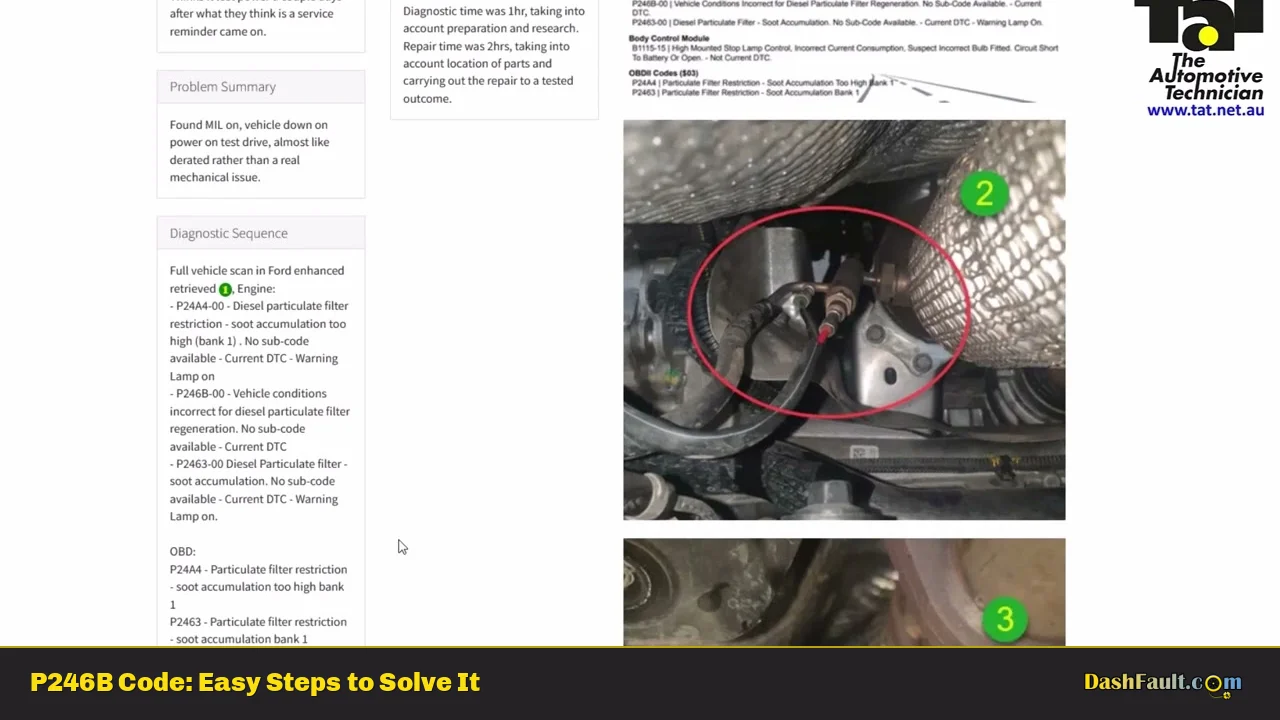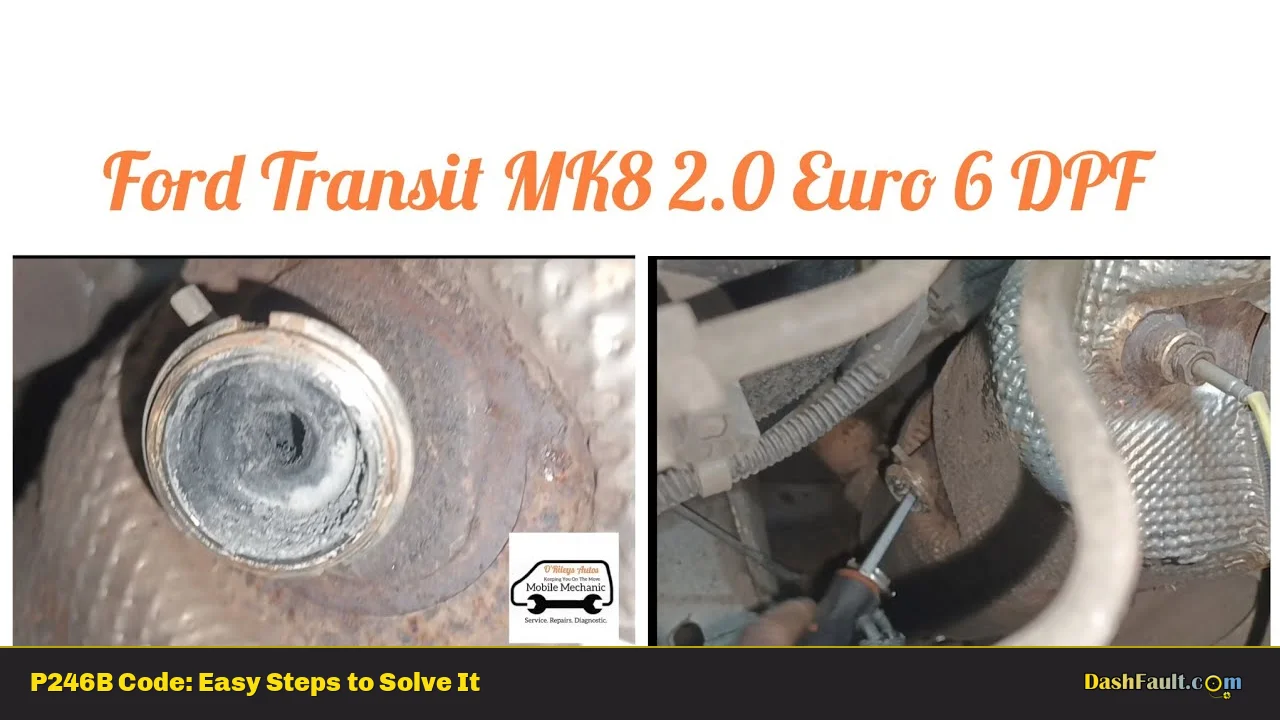The P246B diagnostic trouble code (DTC) indicates that the vehicle’s conditions are incorrect for the regeneration of the diesel particulate filter (DPF). This code is primarily associated with diesel engines and signifies that the engine control module (ECM) has detected a malfunction in the DPF regeneration process. When this code is triggered, it can lead to reduced engine performance, increased emissions, and potential damage to the exhaust system if not addressed promptly.
| P246B Code Meaning | P246B Code Common Causes |
|---|---|
| Vehicle Conditions Incorrect for Particulate Filter Regeneration | Full or clogged DPF |
| DPF Regeneration Process Aborted | Faulty differential pressure sensor |
| Insufficient Engine Temperature | Electrical issues in the DPF circuit |
| Engine Coolant Temperature Too Low | Faulty ECM or software issues |
| Battery Voltage Issues | Exhaust system leaks |
Symptoms of P246B Code
When the P246B code is present, vehicle owners may experience several symptoms, including:
- Check Engine Light: The illumination of the check engine light is often the first indication of a problem.
- Reduced Power: The vehicle may enter limp mode, limiting engine power and speed.
- Poor Fuel Economy: Drivers may notice a decrease in fuel efficiency due to improper combustion processes.
- Excessive Exhaust Smoke: There may be an increase in black smoke emitted from the exhaust.
- Engine Overheating: In some cases, overheating may occur due to restricted exhaust flow.
Technical Explanations
The P246B code is related to the diesel particulate filter’s ability to regenerate. Regeneration is a process where accumulated soot in the DPF is burned off at high temperatures. For successful regeneration, certain conditions must be met:
- Temperature Requirements: The engine must reach a specific temperature for effective regeneration. If conditions are not met (e.g., low coolant temperature), the ECM will trigger the P246B code.
- Pressure Differential: The ECM monitors pressure differences across the DPF. If these pressures indicate that the filter is too full or that regeneration cannot occur, this code will set.
- Electrical Signals: The differential pressure sensor sends signals to the ECM about the DPF’s status. Any faults in this sensor or its wiring can lead to incorrect readings and trigger the P246B code.
Step-by-Step Diagnosis
Diagnosing a P246B code involves several steps:
- OBD-II Scanner Check: Use an OBD-II scanner to confirm the presence of the P246B code and check for any related codes.
- Inspect Freeze Frame Data: Review freeze frame data to understand vehicle conditions at the time of the fault.
- Visual Inspection:
- Check for any obvious signs of damage or disconnection in wiring related to the DPF and differential pressure sensor.
- Inspect for exhaust leaks that could affect pressure readings.
- Test Differential Pressure Sensor:
- Measure voltage output from the differential pressure sensor while running.
- Compare readings with manufacturer specifications.
- Evaluate Engine Conditions:
- Ensure that engine coolant temperature is within operational limits.
- Verify battery voltage and charging system functionality.
- Perform Active Tests: If possible, perform active tests on the DPF regeneration process using advanced diagnostic tools.
Solution Methods
To resolve a P246B code, consider these methods:
- DPF Cleaning or Replacement: If the DPF is clogged beyond cleaning, replacement may be necessary. Regular cleaning can prevent buildup.
- Sensor Replacement: Replace faulty differential pressure sensors if they fail tests or show erratic readings.
- Wiring Repairs: Repair any damaged wiring or connectors associated with the DPF system.
- Software Updates: Update ECM software if there are known issues with specific versions affecting DPF performance.
- Exhaust System Repairs: Address any leaks or restrictions in the exhaust system that could interfere with normal operation.
Cost Estimates
The cost of diagnosing and repairing a P246B code can vary widely based on several factors:
- Diagnostic Fees: Expect to pay between $100 and $150 for professional diagnostics.
- DPF Cleaning Services: Professional cleaning services can range from $100 to $300, while replacement costs can exceed $1,500 depending on vehicle make and model.
- Sensor Replacement Costs: Differential pressure sensors typically cost between $50 and $200 plus labor fees.
Warnings and Recommendations
- Professional Help Advised: If you are not comfortable performing these diagnostics or repairs yourself, seek assistance from a qualified mechanic.
- Avoid Ignoring Codes: Ignoring a P246B code can lead to more severe engine performance issues and costly repairs down the line.
- Regular Maintenance: Regularly scheduled maintenance can help prevent issues related to DPF clogging and ensure optimal vehicle performance.
Closing Paragraph
The P246B trouble code indicates significant issues related to your vehicle’s diesel particulate filter regeneration process. Understanding its implications, symptoms, and appropriate diagnostic steps can empower DIY mechanics and vehicle owners to address this issue effectively. While some repairs may be manageable at home, others will require professional expertise. Timely attention to this code will not only enhance your vehicle’s performance but also contribute positively to environmental standards by reducing harmful emissions.
Frequently Asked Questions About P246B
- What does the P246B code mean?
The P246B code indicates that vehicle conditions are incorrect for diesel particulate filter (DPF) regeneration. - Can I drive my car with a P246B code?
While you can drive with this code, it is advisable to address it promptly to avoid further damage. - What causes a P246B code?
Common causes include a clogged DPF, faulty differential pressure sensor, low coolant temperature, and electrical issues. - How do I fix a P246B code?
Fixes may include cleaning or replacing the DPF, replacing sensors, repairing wiring, or updating ECM software. - Is it safe to ignore a P246B code?
No, ignoring this code can lead to reduced performance and potential damage to your vehicle’s exhaust system. - How much does it cost to repair a P246B issue?
The cost varies; diagnostics typically range from $100-$150 while repairs can exceed $1,500 depending on parts needed. - What are symptoms of a clogged DPF?
Symptoms include reduced power, poor fuel economy, excessive exhaust smoke, and illumination of warning lights. - Should I attempt repairs myself?
If you have experience with automotive repairs, you may try; otherwise, consult a professional mechanic.

